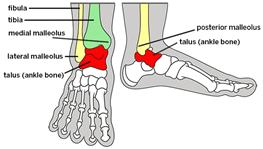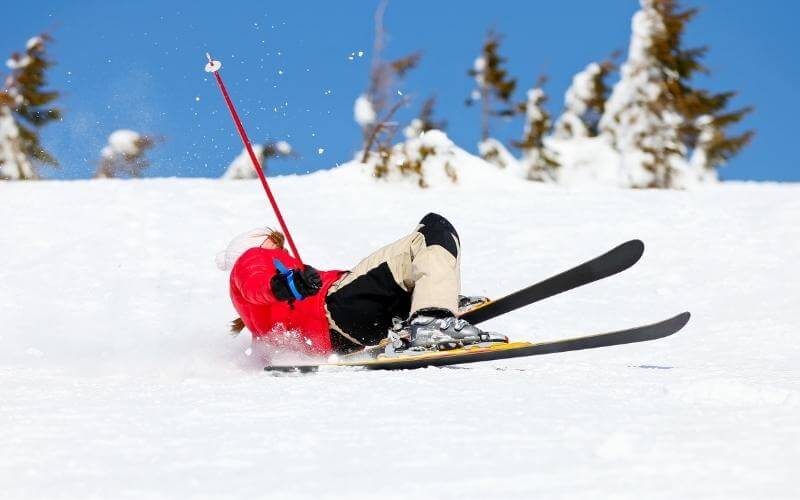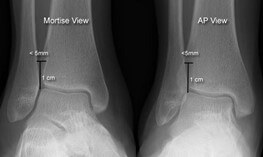Also known as a high ankle sprain, an ankle syndesmosis injury is common in sports such as skiing, rugby and soccer. They involve a different part of the ankle to the usual ankle sprain, which was covered in a previous post. Syndesmosis injuries often require accurate diagnosis and early intervention to ensure proper healing of the damaged structures.
What is a Syndesmosis?
A syndesmosis is an immovable joint that is held together by a strong membrane or ligament. It generally provides stability around the area to allow other parts of the body to move smoothly.
The ankle syndesmosis refers to the connection between the two shin bones known as the tibia and fibula, plus the ligaments that hold these bones together. These bones then sit on top of the talus (ankle bone) to form the ankle joint.
So when we are discussing syndesmosis injuries, we are talking about damage to the ligaments which hold the shin bones together. If these bones are not held together, the ankle will not be able to properly function.
High Ankle Sprains
As the name suggests, syndesmosis injuries will be felt higher up the ankle compared to a regular ankle sprain. It will occur when the ankle is rotated with significant force, which forces the shin bones apart.
A common example of this would be when a skier falls and their ski gets caught in the snow as the skier continues to roll down the mountain. The momentum of their body twisting as the ankle gets caught in the ski can create enough force to tear the ligaments of the syndesmosis.
When the ligaments tear, there is nothing left to hold the shin bones together and they begin to split apart. This makes it extremely painful to walk on and in most cases the injured person won’t be able to put weight onto their foot.
If you have sustained a high ankle sprain you will likely feel immediate pain in the ankle and find it difficult to walk. You may have heard a ‘pop’ or ‘crack’ sound when the injury occurred. Swelling will gradually develop around the ankle and you may even get bruising down to your foot.
X-ray showing separation of the tibia and fibula which indicates a syndesmosis injury
What should I do before I seek help?
The first step is to take weight off the ankle and foot! Weight-bearing on an injured syndesmosis can cause further damage. Your physiotherapist will provide a boot and possibly crutches to prevent further damage to this injury.
Once weight is off the ankle it is advised that you apply the RICE principles for acute management.
- Rest: take weight off the foot and use crutches if needed
- Ice: apply ice packs to the painful areas. You should apply ice for 10 minutes every hour. For more information on icing take a look at our previous post (LINK TO ICE VS HEAT POST).
- Compression: If you have a compression sock, use it to restrict movement of the syndesmosis and limit the swelling. Your physiotherapist will be able to apply taping and possibly a CAMboot to give greater compression to the joint.
- Elevation: Elevate above the level of the heart to drain some of the swelling in the ankle.
How to Manage Syndesmosis Injuries
It is always advised that you seek professional help from your physiotherapist for treatment of these injuries. It is important to have an x-ray of the ankle to assess the degree of separation between the shin bones and rule out any fractures which may be sustained.
In many cases, your physiotherapist will be able to provide support to the ankle and give the torn ligaments the right environment to heal in. If these ligaments don’t heal correctly it can lead to permanent damage to the ankle. In more severe cases, the syndesmosis will require surgical repair. The purpose of this is to pull the two shin bones back together, thus allowing the ankle to function as it previously had.
How Long Before My Injury is Healed?
The prognosis for syndesmosis injuries varies significantly depending on how much separation has occurred at the shin bones. Generally, you would expect double the recovery time compared to a normal ankle sprain. More minor sprains will take 6-8 weeks to fully heal, where bad sprains will take up to three months.
If your syndesmosis needs to be surgically repaired, you would expect 4-6 months before you fully recover. However, this may vary depending on your surgeon and what type of surgery you’ve had.
Summary
Syndesmosis injuries involving the ankle are difficult to manage and can often lead to long periods away from sport.
If not properly diagnosed and managed there is significant risk of long-term damage, chronic instability and development of ankle osteoarthritis.
Early consultation with your physiotherapist significantly improves your chances of a successful rehabilitation.
One-on-One Physiotherapy Care - Complete Attention - You Deserve It !
Contact Us today to find out how we can help you.






